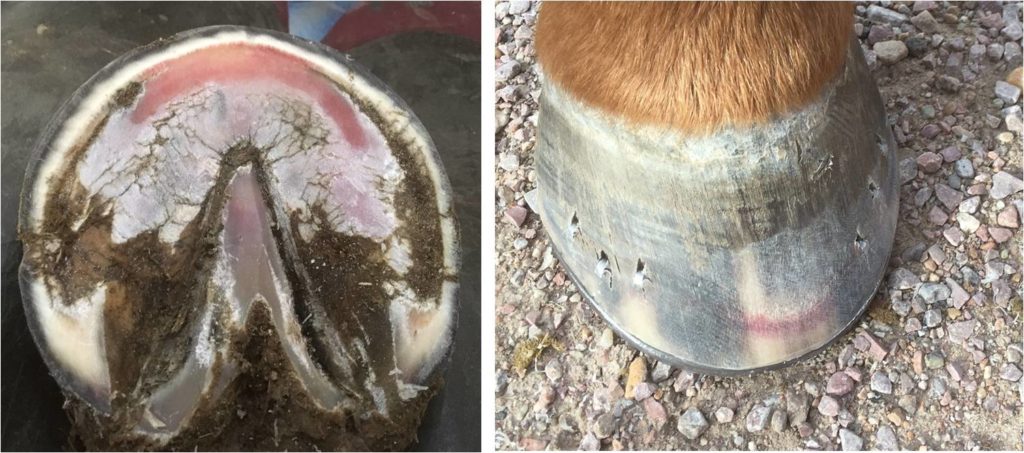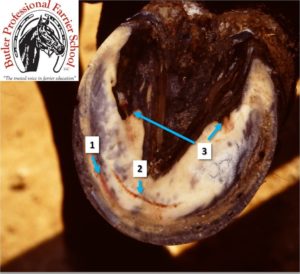Foot Bruises

Foot bruises are a common cause of lameness. They indicate past injuries. Left: Sole bruise caused by sole pressure. Right: Bruise from past injury to the coronary band.
When inspecting a horse’s feet, it can be alarming to see red marks on the outer hoof wall and on the sole. Some owners and beginning farriers might even mistake these red spots for fresh blood! However, most of these spots are remnants of past injuries known as bruises. They are simply evidence of an injury that may have happened several months ago. Foot bruises are a common affliction of athletic and working horses. The condition may be more prevalent in horses that live in rocky terrain. Bruises can cause horses to become lame in varying degrees.
Foot bruises in horses occur the same way that bruises occur on people. Blood vessels rupture from trauma and the leaked out blood collects and stains the injured location. In soft tissue areas of the body (skin), the bruised area might also swell. However, in the rigid hoof, pain can result from the leaked out fluid filling an area that does not expand. Think of a person smashing their finger and a blood blister forming under the fingernail. The pain is greater under the fingernail than if the bruise was elsewhere on the hand where the afflicted area could swell up. This swelling inside an enclosed space is known as compartment syndrome. If the leaked out fluid of the bruise fills up the enclosed space, it can cause tissue death to surrounding areas because blood cannot flow freely. In this necrotic (dead) tissue is where abscesses may form.
Sole bruises can be caused by excessive weight bearing on the sole from balled-up snow or rocky ground. Full leather or plastic pads will protect a horse with thin soles that bruise easily. Snowball pads are a good idea for horses that wear shoes (especially bar shoes) through the winter months. Poorly fitted shoes can also cause sole pressure and subsequently cause bruises. Shoes should be seated out on the inside foot surface of the shoe to prevent this from happening. Horses with flat soles or dropped soles are especially susceptible to bruising. Soles should never intentionally be made to bear weight due to the rich blood supply of the sensitive sole. The hoof wall is meant to bear the weight of the animal.
Bruises can be indicative of other ailments as well. The condition may be a symptom of other problems. Bruises that consistently appear in the white line may indicate heel pain (navicular pain) as the horse is stabbing the toe into the ground to prevent landing on its heel. It might also be due to bone spavin or other high limb lameness. A consistent bruise in the shape of a half moon over the sole is a sign of the coffin bone being inflamed (pedal osteitis). This may be a symptom of laminitis or founder. Bruises in the back of the foot in seat of corn are known as dry corns. Bruises that show up on the outer hoof wall are signs of a past injury to the coronary band; not the hoof wall itself. When observing any of these types of bruises, it is best to treat the root cause—not just the bruise.

Bruises are characterized by location. 1) Bruises in the white line can mean that the horse is stabbing its toe when it walks; 2) Half-moon shaped bruise is the outline of the coffin bone. It indicates inflammation of coffin bone (pedal osteitis) due to sole pressure or laminitis; 3) Small sole bruises around the foot may be caused by sole pressure or trauma from rocky trails or snow and ice.
Most bruises are not serious enough to make a horse lame. They might just look worse than they actually are. Bruises are easier to observe on white feet. This is one of the reasons that a lot of horsemen believe that white feet are of inferior quality to black feet. However, black feet are just as susceptible to bruising; it is just harder to see the bruises!
If a bruise does become a problem for a horse, there are many treatment options available. Plastic or leather pads as well as seated out shoes can protect injured feet. A wide-webbed, seated-out shoe should be used for flat-footed horses. Vettec makes several soft composite hoof cushions that can be injected in the bottom of the foot to prevent severe bruising. To prevent bruises to the outer, upper hoof wall, the coronet should be protected. Horses that have a tendency to hit themselves (interfere) may benefit from a bell boot or other hoof covering for the duration of the ride.
Simple bruises usually show signs of improvement within a few days.
Related Posts
-
With the holidays approaching, we are offering a discount on...Nov 30, 2017 / 0 comments
-
This question and its answer depends upon your experience, l...Dec 28, 2009 / 0 comments
-
Tips to Increase your Value in Customer Relationships ©2017...Oct 19, 2017 / 0 comments
Blog Categories
- Anatomy
- Best Business Practices
- Conformation
- Current Events
- Customer Service
- Draft Horse Shoeing
- Equine Soundness
- Essential Anatomy Kit
- Farrier Careers
- Farrier training
- Foal soundness
- Horse Care
- Horse Foot Care
- Horse Owner Tips
- Horsemanship
- Horseshoeing
- Horseshoeing History
- Iron and Forge Work
- Student Spotlight
- Uncategorized
- Veterinary Care
Blog Archives
Contact Us
Butler Professional Horseshoeing School
495 Table Road
Crawford, NE 69339
(800) 728-3826
jacob@dougbutler.com
Subscribe to Our Blog
Get Our Free e-Book!
If you think you want to become a farrier (or know someone who does), this book can help you make that decision. Horse owners will learn the importance of choosing a qualified farrier and how to select the “right” one.
[ Get the e-Book Now! ]
- Follow:
